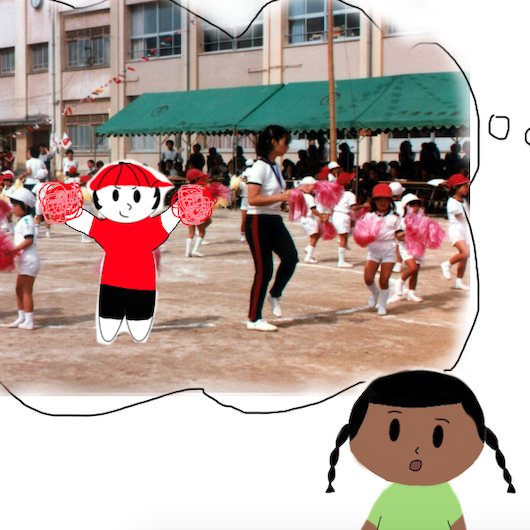TO READERS OF THIS BOOK
While reading this book, think about your experiences playing sports in school.
ABOUT THE AUTHOR
Text by: Jada and Jillian(ジェダ&ジリアン)
Illustrations: Jada (ジェダ)
Jada and Jillian are students at Smith College. Jada is an East Asian Language and Literature major. Jillian is a Chemistry major. In their free time, Jada enjoys reading and Jillian enjoys dancing.
ABOUT THE BOOK
This book was written for Japanese III and published in May 2019.
KEY WORDS:
体育(たいいく)physical eduction (P.E.); 運動会(うんどうかい)sports day; 応援(おうえん)cheering
Tadoku Level: 0
Plot Summary:
Did you have field day growing up? Did you know Japan also has a version of field day? It’s called 運動会(undoukai). Join Jada and Yasutomo as they explain the differences between undoukai and field day and explore the true meaning of 運動会.
RELATED SUSTAINABLE DEVELOPMENT GOALS (SDGS)
This tadoku book is intended for young Japanese language learners to improve their reading ability. This book also explores the following SDG’s (Sustainable Development Goals):
- Goal #3 – Good Health and Well-Being
- Goal #4 – Quality Education
- Goal #11 – Sustainable Cities and Communities
- Goal #17 – Partnership
AUTHORS’ NOTES
1. Why did you create the story?
I created this book because Japanese learners need a way to engage with Japanese in a way that is interesting and fun, since learning is easier when you’re interested in the subject matter. The PS147 students, for whom this book was written, seemed very interested in P.E., so that became the subject of this book. The differences between Japan and America are also interesting and important parts of learning a language, so this book attempts to introduce the familiar and then explain the unfamiliar to help learners of Japanese become interested in the country as well as the language.
2. How does the story address SDG #4 (quality of education)?
P.E. (Physical Education) is an important and fun part of school life. Field day, or undoukai, in particular are entire days dedicated to P.E. Field day and undoukai aren’t just about being physically healthy though, they’re also used to teach young children teamwork. This story explores a different side of education than just sitting in a classroom and outlines how even things that are fun, like field day, are learning experiences.
3. How did interviewing possible readers influence the design process?
It was important to hear from the readers to help adjust the language and grammar used in the book. Words and sentences that seemed simple to me were complex to readers with a lower language level. It also changed the illustrations for the book, because originally the characters were cat people, but the readers wanted humans characters, so they had to be redesigned.
4. How did receiving written feedback from possible readers influence the design process?
Written feedback helped narrow down the most important feedback that was mentioned in the interview.
5. What challenges did you encounter when adapting your story?
The first interview after reading the draft was very challenging because I had designed the characters as cat people and finished about half of the illustrations, but I had to change that. It was also very hard making the sentences simpler without changing the story too much.
6. What was most frustrating about the process? Most rewarding?
It was really frustrating when I had to redesign all the characters, but it was also the most rewarding when the children liked the new designs.
7. What did you find helpful to get you through it? What were your solutions to the challenges you identify #5 and why?
As me and Jillian edited the book, we just kept making things simpler and simpler, removing and replacing words until the book was level 0. In terms of redesigning the characters, it was hard at first, but I actually took some inspiration from another classmates book whose illustrations were much better received.
8. Where did you apply the most creativity in your book?
Probably the art, but making the story easier while keeping the same plot also took a lot of creativity.
9. What advice do you have for students who are interested in creating Tadoku books for young learners?
Keep in mind the difference between your level of Japanese and your audience’s level of Japanese. Even if you like a word or grammar structure might not be hard, double check that thought and consider that one or two difficult grammar structures can feel like a lot for someone younger.
10. How was your overall experience? (Please provide thoughts and takeaway on the project.)
This project was hard, but ultimately rewarding, especially when the readers gave positive feedback for the new character designs.
11. What makes your book unique from a book written by native Japanese speakers and why?
Because I am not a native speaker, the way I structure my sentences and the words I use are easier to follow for another person learning Japanese as a foreign language. For someone who is a native speaker it is probably a lot harder to know which words and grammar are simple and which are hard. For some people, having harder words mixed in with easier words can be okay, but for young learners more familiar and simple grammar is preferred.
Full Version:
College students; Tadoku Level (1)
